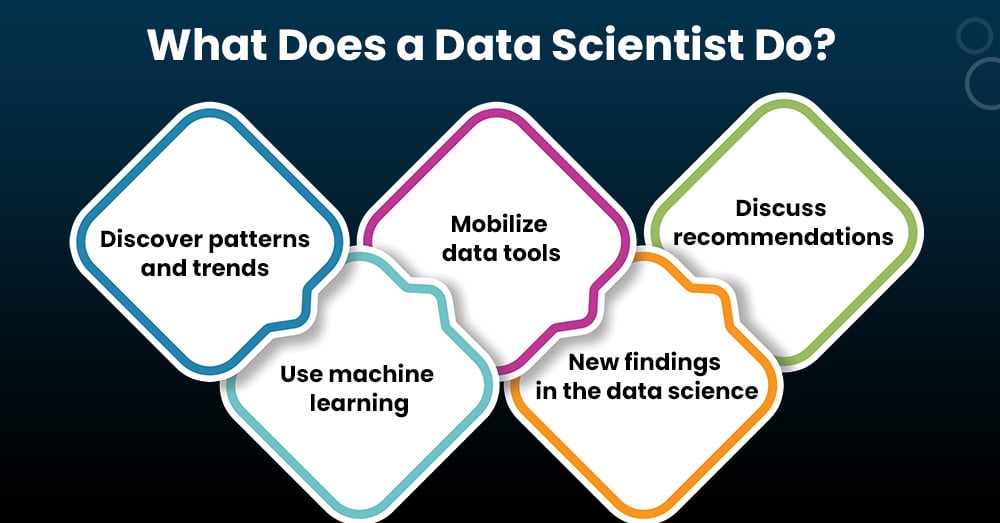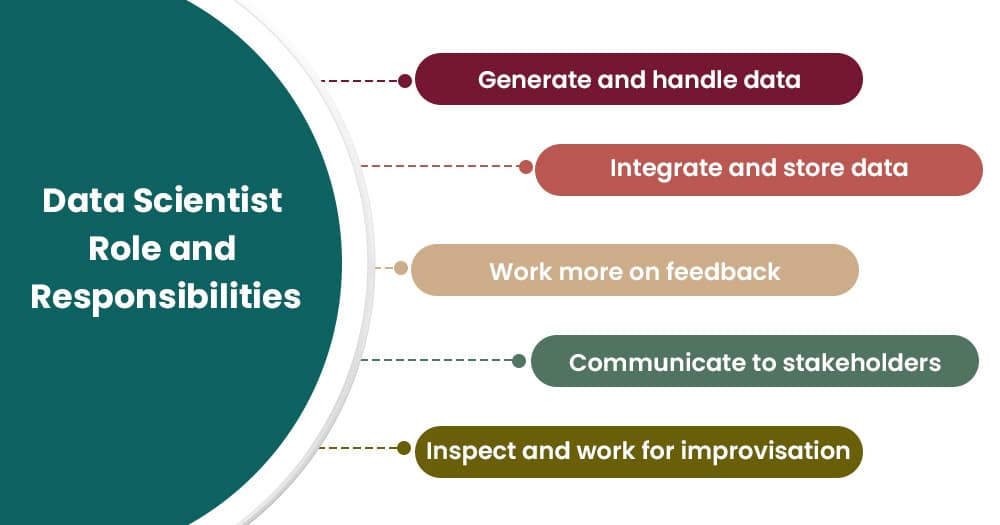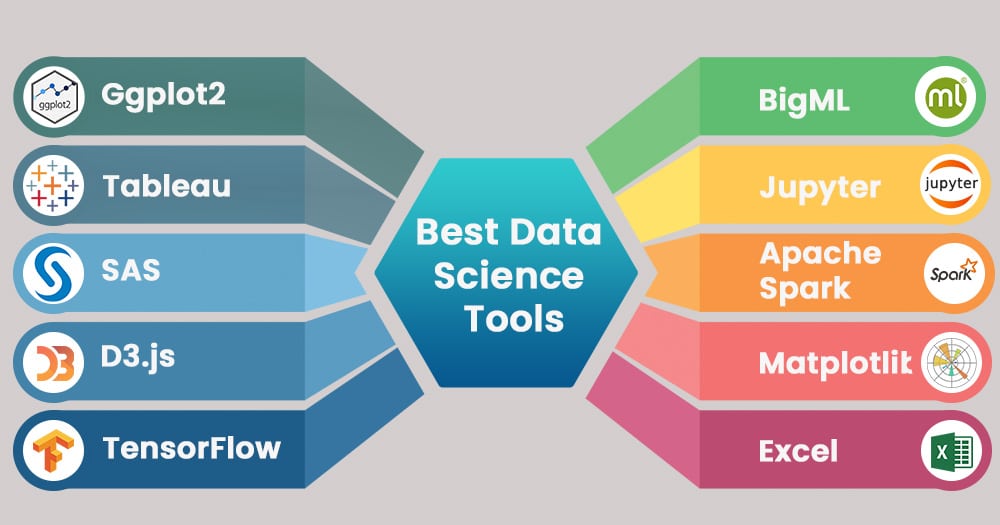Data science is wizardry in today’s run for business as it helps extract meaningful insights from every nook and corner and encourages efficiency in decision making. The tasks involved can appear to be backbreaking on the intellectual front but the analytical outcomes it brings out are gratifying for any organization. According to the US Bureau of Labor Statistics, the occupations surrounding data science are anticipated to hike by 31 percent between 2019 to 2029 and that is a big deal.
So what is data science and how to become a Data Scientist? Let’s explore everything in this section.
What is Data Science?

Data science refers to the study of data that utilizes programming skills, mathematics and statistics to obtain useful insights from data. Companies, on a big note, are acknowledging the significance of data science regardless of their size or industry. In order to stay under the umbrella of competition, organizations are shifting towards the development and implementation of data science techniques.
We are in the era of Artificial Intelligence and big data. You are not overestimating data if you are calling it a magic wand for companies. It helps companies dive to the depth of information and leads to enhanced decision-making by stirring raw data into crucial insights. You might be interested to learn how to build an AI app.
What Does a Data Scientist Do?

The role of data science practitioners brings computer science, mathematics and statistics to a commonplace. Data Scientists process and model data and then carry out an interpretation of the final outcomes for creating strategies for companies.
Here are the tasks many Data Scientists usually perform on a day-to-day basis:
- Develop algorithms as well as data models to predict outcomes and make data driven decisions.
- Discover patterns and trends in datasets to unfold insights.
- Use machine learning tactics in order to better the quality of data/ product offerings.
- Discuss recommendations with other teams and senior staff.
- Mobilize data tools like Python, R, or SQL in data analysis.
- Be in pace with the new findings in the data science field.
Why You Should Become a Data Scientist?
The field of data science is expanding and this is how an endless number of job opportunities are making their way in. If basking in intellectual errands and amping up decision making for a rewarding business thrills you then you already have the foremost reason to consider data science as your career destination.
Since this field is spreading its wings and paving a way for job options in ample numbers, it’s safe to say that you will have a long and bright career to a tremendous extent. Besides, by jumping your way into this option, you will have a chance to work with the business giants of the world. On top of everything, the job of Data Scientist is one of highest paid ones with an average of $100,500 per year.
Data Scientist Role and Responsibilities

The work of Data scientists involves interacting with business stakeholders to comprehend their business goals. It helps them gauge how they can use data modeling processes, make algorithms and predictive analysis to achieve those business requirements. Each industry and project is different. However, the roles and responsibilities of Data Scientists on the common ground include the following:
- Generate and handle data.
- Integrate and store data.
- Choose one or multiple potential algorithms and models.
- Carry out data inspection and exploratory data analysis.
- Use data science techniques like statistical models, statistical analysis systems, machine learning, and artificial intelligence.
- Inspect and work on outcomes for improvisation.
- Communicate the final result to stakeholders.
- Work more on them as per the feedback received by stakeholders.
Must-Have Skills to Become a Data Scientist

When you are seeking an advanced position, you need to be equipped with a compelling suite of skills in order to ace your career. When it comes to the position of Data Scientist, there are many skills you need to acquire irrespective of the roles and responsibilities for specialized Data Scientists. Let’s take a look at at the tray of skills required to become a Data Scientist:
Mathematics and Statistics
Data Science professionals have a stronghold over math and statistics. Any organization, whether or not they are data-focused, demands individuals to know and understand the ways to approach descriptive statistics which includes advanced analytics, predictive models, predictive analysis, distributors as well as statistical tests. It helps them be able to make sound recommendations and data driven decisions.
Data Analytics and Modeling
In order to accomplish an agenda in this field, Data professionals need to be skilled to perform data analytics and modeling. Any company will expect you to possess deep learning in this case. You should be able to analyze data and create models in order to gain new insights and forecast outcomes.
Machine Learning Techniques
While you may not have an expertise in the field of machine learning applications or machine learning algorithms, you will still be expected to at least have some knowledge on it. The essential elements of machine learning include logistic regression and decision trees. When you are applying for data science positions, know that potential employers will be expecting you to have this side of knowledge.
Programming
Apart from data analytics and data manipulation, data scientists need to have a strong suite of programming skills in order to ace the creation of data science applications. Most employers expect data scientists to know Python language and R and many other programming languages. In this realm, you can try touching on object-oriented programming, flow control statements and libraries, basic syntax and functions.
Data Visualization
Data visualization is a major element of becoming a professional in data science, given that you will be required to intimate key messaging effectively. You should be able to comprehend how to split complicated data infrastructure into tinier components. You should also be able to visualize data.
Communication Skills
Since data won’t be able to communicate on its own, you must know the art of data manipulation and be able to have top-notch communication skills. From intimating data science teams about the steps required to be followed to achieve a goal related to data architecture to giving a presentation, communication will prove to be a major differentiator in the final results.
Top Careers in Data Science

One of the amazing parts about the field of data science is that it unravels a variety of roles before you. So, you can choose the right job from multiple options available whether you’re a newcomer, or you’re a professional looking for a change.
Data science practitioners work in different industries and disciplines. Here are the most popular and high-paying career options in data science:
- Data Scientist
- Data Analyst
- Data Engineer
- Data Architect
- Machine Learning Engineer
- Statistician
- Business Analyst
- Database Administrator
- Data and Analytics Manager
- Researcher
- Quantitative Analyst
Best Data Science Tools

Learning how Data Science tools work will help you excel brighter in a Data Science career. Here are the best data science tools available out there:
SAS
SAS is a data science tool that is specially designed to contribute to statistical operations. It uses the base SAS programming language to perform statistical modeling. This software is used by large-scale businesses for big data analysis.
Apache Spark
Apache Spark or Spark is an analytics engine that is used the most as a Data Science tool. It is specially designed for looking after the batch processing, data preprocessing and streaming data.
BigML
BigML is yet another popular Data Science Tool for Data Scientists that offers a completely communicative and cloud-based GUI environment which can be used to process Machine Learning Algorithms. This tool brings standardized software practicing cloud computing.
Tableau
Tableau is one of the widely used data science tools. It is a data visualization software enriched with powerful graphics that help create interactive data visualizations. This tool is dedicated to industries based in the field of business intelligence.
D3.js
D3.js, a Javascript library that helps Data Scientists create interactive visualizations on their web-browser. Using various APIs of D3.js, they can take a hand from a number of functions for making dynamic visualization as well as analysis of data in the browser.
TensorFlow
TensorFlow is counted as a standard tool for practicing ML. This tool is incorporated for advanced machine learning algorithms such as deep learning.
Jupyter
Jupyter is one of the widely used data science tools that is based on Python. This open-source tool helps developers make open-source software and backs a range of languages like Python, Julia, and R.
Excel
You probably already know about this one. Excel is a powerful data science tool developed by Microsoft majorly for spreadsheet calculations. Today, this tool helps with visualization techniques, data processing, and complex calculations.
Matplotlib
It is a plotting and visualization library created specially for Python. Matplotlib is the most popular tool when it comes to generating graphs using the analyzed data. It is widely used for plotting complex graphs with the help of simple lines of code.
Ggplot2
Then there is ggplot2 – an advanced data visualization tool made for R. This tool is created in order to replace the native graphics package that comes with R. ggplot2 uses robust commands for creating illustrious visualizations.
How to Become a Data Scientist?(Step-By-Step Guide)

Here is a step-by-step guide to become a Data Scientist:
Learn the Right Data Skills and Data Science Fundamentals
If you are a newbie to data science and have no idea how it works then your first step is to create the background for working as a data scientist. The foremost part of acing the data scientist career is to encompass the breadth of knowledge in the concerned field before you jump on to the degree part. The area of knowledge, here, could cover engineering, data analysis, IT, mathematics and finance.
But everything is incomplete without the very fundamentals of data science which include SQL, Python programming language and Excel. It is best to opt for a bootcamp or a data scientist course to fathom the data science fundamentals. There, you will be able to acquire skills like how to store data, how to analyze and model data and the art of presenting data using the tools that are there in the data science toolkit such as Tableau and PowerBI.
Learn Essential Programming Languages
Data Scientists count a lot on a range of specialized tools and programs. These tools and programs are created specifically for data cleaning, analysis, as well as data modeling. The required knowledge goes beyond Excel and entails statistical packages of programming languages which include Python, R, and a query programming language like SQL.
The practice of data science also involves machine learning, a set of tools that bring in artificial intelligence for helping systems with the ability to learn as well as be accurate without the condition of being explicitly programmed. The tools incorporated for machine learning rely on the application. Data Science experts can choose from a myriad of tools like TensorFlow, h2o.ai., and Accord.Net. You might be interested to know the difference between Artificial Intelligence Vs Machine Learning Vs Data Science.
Use Data Science Projects to Develop Skills
After learning the basics of the data science tools and programming languages, you can take on projects that allow you to make use of your acquired skills. During your practice, try to cover different phases of the process starting from the research on the market or company. While industries use their own kinds of data in order to make informed decisions, it is best that you try to learn as many data types as possible.
Once you’ve learned how to use descriptive analytics to scrutinize data for patterns, you will be able to tackle statistical techniques such as predictive analytics, predictive modeling, data mining, and machine learning.
Create and Practice Visualizations
Next step to become a Data Scientist is to practice creating your own visualizations using programs like Tableau. Know that Excel is here in the picture as a useful tool for making calculations and graphs. However, developing a stunning data visualization is not all that you need to do.
You must be able to use the data visualization you create to present your discoveries to the audience as it will help chisel your communication skills. You can practice it by starting small and communicating them to a small group or your friend or even to yourself in the mirror.
Looking To Hire Python Developer?
Request A Free Quote
Build a Portfolio
Now that you are done with your preliminary research, training, and skills, it is time to design a portfolio that showcases all your leanings and projects. Demonstrating training, qualifications, skills and projects will help your portfolio look polished and boost your chance at landing your dream job as a Data Scientist.
Github also is an easy-peasy way to display the process you have been through, your work and the outcomes. Make sure you profile your data with a stunning narrative and also, demonstrate the challenges you have faced and solved. You must keep it in mind that there is no need to put the head-to-toe of your work. Make only those pieces brim on your profile that are closely related to the Data Scientist post you are applying for.
Apply for Jobs
You will find a number of titles in the field of data science including Data Engineer and Data Analyst. Before you apply for a job, check what a company is looking for, and their goals to see if you can use your skills to help them.
Data Science Courses and Qualifications
There are more than one or two gateways to make a career in data science. But for starters, you have to enroll for a college education to give a flight to your intent. It is to be noted that 38% of the data science practitioners have a PhD while the rest have a graduate degree.
Data science degrees help you with the prerequisites of the process and analysis of a complex data set. They also teach technical information related to mathematics, analysis techniques, and so on. Many schools provide data science degrees and that is the foremost option to go with.
You must have an undergraduate/ postgraduate degree in a related discipline to work in the field of data science. You can opt for graduation in computer science, Business information systems, Mathematics and Statistics or Economics.
Furthermore, certification in data science courses can help profile your resume to an incredible extent. You can take up online data science courses that teach Linear Algebra, Statistics and Probability.
Apart from that, you must also try to touch on the following subjects:
- Information extraction
- Computer vision
- Bioinformatics
- Database management, data analysis and database designing
Apart from that, data science programs also feature a creative and analytical segment that exposes you to skills like judgment and decision making – the essential parts of the data science process.
Data Scientist Salary

A Data Scientist salary travels high and low depending on factors such as experience, region and skill set. Also, considering the average, it does not differ much from the salary of Data Analysts or Data Engineers.
While the average Data Scientist salary is $100,500 per year, the figure is tweaked by the level of expertise. For instance, an entry level Data Science practitioner gets $95,000 per year whereas an experienced Data Scientist salary goes up to $250,000 per year.
The region is also a highly notable factor contributing to the salary. Let’s take a look at the average Data Scientist salary in the USA, UK, Australia and India.
| Country | Average Annual Salary (in USD) |
|---|---|
| USA | $120,000 |
| UK | $70,413 |
| India | $13,540 |
| Australia | $115,000 |
Difference Between a Data Scientist, Data Analyst and Data Engineer

The world of data is a vast one and it is studded with an endless count of job openings. Given that, it is easy to get confused among major data-related job titles, especially Data Scientist, Data Analyst and Data Engineer. To save you from this confusion, we have brought you a brief explaining the differences between these positions.
Data Scientist
A Data Scientist is the one who inspects and interprets big data. One can start off with a career as a Data Scientist by developing enough skills in the field. The data science skills include advanced statistical analyses, knowledge about big data tools, a complete understanding of ML, preparing data, cleaning, data conditioning etc.
Data Analyst
In order to qualify for the position of a Data Analyst, you need to have a bachelor’s degree and statistical knowledge. If you have technical skills then take it as a brownie point which will help you come on the list of preferred applicants. A Data Scientist is also well-armed with the knowledge on data handling, data modeling along with a strong knowledge of the business world.
Data Engineer
Data Engineers are the ones who carry a stellar technical profile. To become one, you need to get a master’s degree in the related field. You should also be able to understand the data pipelines as well as performance optimization alongside working with structured as well as unstructured data.
Data Scientist vs Data Analyst vs Data Engineer – Salary
If we talk about the Data Scientist salary, it averages about $100,400 per year. The Typical data analyst salary falls under $60000 per annum while an average data engineer salary is $90,830 per annum. As you can get it from these figures, the salaries of Data Scientists, Data Analysts and Data Engineers do not differ much. Depending on the experience and large vantage view of the career growth, these positions can bring about significant contrast in the numbers.
Data Scientist vs Data Analyst vs Data Engineer – A Comparison
| No. | Data Scientist | Data Analyst | Data Engineer | |
|---|---|---|---|---|
| 1. | Definition | Data Scientist are the ones who analyze and interpret complex and big data models | Data Analyst are the ones who perform analysis of numeric data and make better decisions using it. | Data Engineer entail preparation of structured and unstructured data along with the development, construction, tests as well as maintenance of entire architecture. |
| 2. | Roles and Responsibilities | Data Scientist Developing Operational Models Executing data analytics as well as optimization with the help of ML and deep learning Integrating data as well as perform data analysis Strategic planning for data analytics Help stakeholders interact with customer | Data Analyst Developing Operational Models Executing data analytics as well as optimization with the help of ML and deep learning Integrating data as well as perform data analysis Strategic planning for data analytics Help stakeholders interact with customer | Data Engineer Developing, examining and maintaining architectures Deploying ML and statistical models Understanding programming Build pipelines for various ETL operations Keeping up with data accuracy and flexibility |
| 3. | Average Salary | Data Scientist Average salary is $100,400/ year. | Data Analyst Average salary is $60000/ year. | Data Engineer Average salary is $90,830/ year. |
On Your Skills, Get, Set, Land a Job!
If you love complexity, telling stories in the form of data, stats and linear algebra and above all, if you have patience and judgment skills to get to the nerve of insights using data sets then you can consider data science as your blissful career option. The data world is more active and fierce than ever today. It is opening doors to meaningful analytics and transformation for companies. So, with the right skill set and loads of analytical approach, there’s no stopping for you to thrive in this career.
Great Together!
![A Guide on How to Become a Data Scientist [Role and Responsibilities]](https://theninehertz.com/wp-content/uploads/2022/02/What-is-Data-Science-and-How-to-Become-a-Data-Scientist.jpg)









